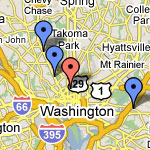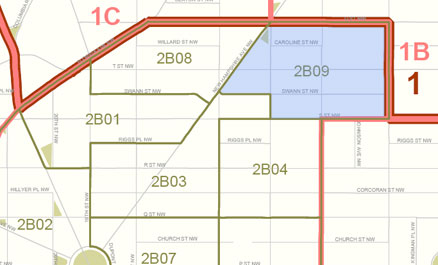Better Know a Single-Member District: 2B09
Calling this “the fightin’ 2B09” is a more genuinely apt mantra in this Single-Member District than in many others. The violent riots of 1968 still leave their mark on DC’s traditionally African-American commercial corridors such as 14th Street, 7th Street, and H Street. They are still recovering from the destruction, closed businesses, and subsequent population loss.
Today, most of these corridors are alive with new development and its consequent controversy, leading to fights of words instead of rocks, but still very passionate. Today’s Better Know a SMD looks at the archetypal revitalizing commercial corner and the spot where the 1968 riots began: 14th and U.
Observers point to two events as cornerstones of 14th and U’s transformation into the lively housing, restaurant, and entertainment district it is today: the opening of the Reeves Center in 1986, and the first service at the U Street Metro station in 1991. Some dispute the influence of the Reeves Center, but none disagree that Metro has fueled a powerful resurgence.
The area has many new condo buildings (like Langston Lofts and the Ellington) to the north and east of 14th and U, and multiple restaurants and bars (such as Saint-Ex and Bar Pilar) on the east side of 14th south of U. 14th’s the west side, however, has been slower to develop, still sporting a McDonald’s, several other fast food restaurants, a parking lot, and several vacant buildings at 14th and T.
That southwest corner is the very edge of the Dupont Circle ANC and SMD 2B09, while the other three corners of 14th and U are all part of ANC 1B. Critics of 2B09’s commissioner and 2B’s current chair, Ramon Estrada, say the imbalance between the more vibrant eastern side and 2B09’s western side comes from Estrada’s opposition to projects in his district, compared to more business-friendly positions from ANC 1B.
Estrada insists he supports development and businesses in his district. “I would like to see 14th and U commercial corridors revived with vibrant live/work/
dine/arts-rich establishments,” he said, “including galleries, theatres, and more museums about the cultural history of U Street. This vision is currently taking shape and, if financing continues to be available, the remaining remnants of the destruction from the 1968 riots will be seen only in photographs.” Still, Estrada has been a constant opponent of the scale of proposed development at 14th and U, advocating for 7 stories instead of 10 at the tallest point. I’ve criticized that stance throughout, and in recent months, several of Dupont’s ANC commissioners have spoken up to oppose Estrada’s push for further reductions.

Ramon Estrada and Doug Rogers.
Doug Rogers decided to run against Estrada because he believes most neighbors don’t share Estrada’s positions on development and retail. “I really want this district to have first-rate residential, retail, and transportation,” he said. “The west side of 14th is empty, with vacant lots and vacant warehouses, but if you look across 14th Street to the east side, it’s full of life. It has diverse, mixed retail along that space between S and U and a lot of vitality. Meanwhile, the west side is dead.”
Rogers doesn’t support just any development proposals uncritically, nor skyscrapers at 14th and U, but would build a greater level of consensus between developers or business owners and neighbors. For example, Constantine Stavropoulos, owner of Tryst and the Diner in Adams Morgan and Open City in Woodley Park, announced plans this summer to open a Tryst/Diner combination restaurant at 14th and T, along with a comedy club, yoga studio, and dance company. Estrada took a firm stance against 24-7 operation and sought to limit outdoor seating, saying that “constituents in close proximity have contacted me to register their concerns.” Rogers thinks the constituents Estrada mentions are a “vocal minority,” and that the neighbors he’s spoken with are almost universally “ecstatic about the possibility of a coffee house. They have concerns here or there, but want to ensure it gets opened there. … [Estrada] is not listening to what neighbors want, and the neighbors’ opinions are not making it into the ANC.”
Rogers feels that anti-development attitudes from ANC 2B drive businesses away. “You don’t start a conversation with a business owner by saying you’re not going to do x, y, or z, period,” he said. “Starting with a hostile attitude, you scare off businesses, who’ll say, ‘why don’t I go across the street where the ANC is more sympathetic?’” Several 1B residents and business owners agree that, at least in their opinion, 1B is a friendlier forum to business.
Rogers moved to DC in 1991 to work in politics; coming from Texas, he grew up a Republican, but switched his party loyalty to the Democrats after learning more about the values of each party. He’s lived in the Dupont Circle neighborhood for ten years and now works as a CPA. Rogers became a Smart Growth convert after seeing the “cartoonish, cheaply made big box retail” throughout the nation, and after reading Jane Jacobs, Howard Kunstler, and other influential urbanist thinkers.
Estrada, who grew up on the West Coast, has been in DC for thirty years and has run “various trade associations.” He now trains and advises boards of directors on, among other things, how to run meetings, which guides his stewardship of ANC 2B meetings as the chair. Estrada cited neighborhood issues like public safety and liquor licenses as the impetus for joining the ANC in 2002.
Wednesday’s Better Know a SMD, 7D06, touches DC’s highest pedestrian crash intersection, Minnesota and Benning. 14th and U is DC’s number two, and safety is top of mind for both candidates. Estrada lauded recent signal changes to add leading intervals, where pedestrians begin crossing before cars are allowed to move. “I also think the bump-outs at intersections, like shown on both the 14th Street & U Street Streetscape designs, will be a welcome improvement.” As for bicycles, Estrada brought up constituent suggestions that bike safety training be part of the driver education process.
Estrada would like to see more parking at 14th and U, though he also lauds the conversion of surface parking lots into other uses. He’s pleased with the promise of parking for restaurant patrons inside the 14th and U project, and cited proposals floated in the past for a municipal parking lot.
Estrada is also skeptical of performance parking’s promise, saying the neighborhood “needs more daytime activity to support our businesses; therefore it seems extremely important to make it convenient for visitors to come via all modes, including cars. … We want people from outlying areas, out-of-state and from abroad to come to our neighborhood and have an enjoyable experience.” Performance parking supporters contend, however, that performance parking actually makes it more convenient rather than less for visitors to arrive by car by ensuring availability of parking spaces.
Estrada and Rogers both appreciate 14th and U’s bountiful public transportation. Estrada feels the 14th Street bus currently works well, but would welcome the addition of a Circulator; Rogers feels that 14th, 16th, U, and the connector to Adams Morgan could all use more service and “would love to see light rail one day” in the neighborhood.


